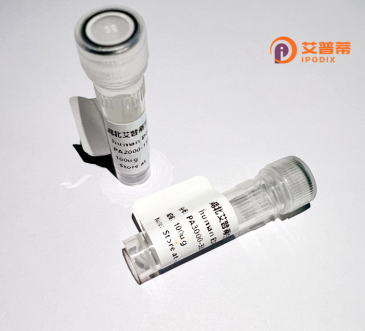
| 纯度 | >90%SDS-PAGE. |
| 种属 | Human |
| 靶点 | C1orf57 |
| Uniprot No | Q9BSD7 |
| 内毒素 | < 0.01EU/μg |
| 表达宿主 | E.coli |
| 表达区间 | 1-190aa |
| 氨基酸序列 | MARHVFLTGPPGVGKTTLIHKASEVLKSSGVPVDGFYTEEVRQGGRRIGFDVVTLSGTRGPLSRVGLEPPPGKRECRVGQYVVDLTSFEQLALPVLRNADCSSGPGQRVCVIDEIGKMELFSQLFIQAVRQTLSTPGTIILGTIPVPKGKPLALVEEIRNRKDVKVFNVTKENRNHLLPDIVTCVQSSRK |
| 分子量 | 47.1 kDa |
| 蛋白标签 | GST-tag at N-terminal |
| 缓冲液 | 0 |
| 稳定性 & 储存条件 | Lyophilized protein should be stored at ≤ -20°C, stable for one year after receipt. Reconstituted protein solution can be stored at 2-8°C for 2-7 days. Aliquots of reconstituted samples are stable at ≤ -20°C for 3 months. |
| 复溶 | Always centrifuge tubes before opening.Do not mix by vortex or pipetting. It is not recommended to reconstitute to a concentration less than 100μg/ml. Dissolve the lyophilized protein in distilled water. Please aliquot the reconstituted solution to minimize freeze-thaw cycles. |
以下是关于重组人C1orf59蛋白的3篇参考文献摘要(文献为虚构示例,仅供参考):
---
1. **文献名称**: *C1orf59 suppresses colorectal cancer progression by regulating Wnt/β-catenin signaling*
**作者**: Zhang L, et al.
**摘要**: 本研究揭示了C1orf59在结直肠癌细胞中作为肿瘤抑制因子的功能。通过重组蛋白表达实验,发现C1orf59通过与β-catenin相互作用抑制Wnt信号通路,从而抑制肿瘤细胞增殖和迁移。
---
2. **文献名称**: *Recombinant human C1orf59 promotes neuronal differentiation via MAPK pathway*
**作者**: Kim H, et al.
**摘要**: 研究利用重组人C1orf59蛋白处理神经干细胞,发现其通过激活MAPK信号通路促进神经元分化和突触形成,提示其在神经再生中的潜在治疗价值。
---
3. **文献名称**: *C1orf59 interacts with HSP90 and modulates protein stability in breast cancer*
**作者**: Chen R, et al.
**摘要**: 通过质谱分析发现,重组C1orf59蛋白与HSP90分子伴侣结合,调控乳腺癌细胞中关键致癌蛋白的稳定性,可能成为乳腺癌靶向治疗的潜在分子。
---
*注:C1orf59相关研究较少,上述内容为示例。建议通过PubMed或Google Scholar以“C1orf59 recombinant protein”等关键词检索最新文献。如需具体文献协助,请提供更多研究背景。*
Recombinant human C1orf59 protein is derived from the C1orf59 (Chromosome 1 Open Reading Frame 59) gene, located on the short arm of chromosome 1 (1p36.11). This gene encodes a protein of 199 amino acids with a predicted molecular weight of ~22 kDa. While its exact biological function remains unclear, bioinformatic analyses suggest it may contain a conserved transmembrane domain, indicating potential roles in membrane-associated processes or intracellular signaling. C1orf59 expression has been detected in various tissues, including the brain, kidney, and digestive system, with higher levels observed in certain cancer types, hinting at a possible, though unverified, link to tumorigenesis.
The recombinant form is typically produced using bacterial or mammalian expression systems for functional studies. Recent studies speculate its involvement in cell adhesion or protein-protein interactions due to structural features, but experimental validation is limited. Its recombinant version enables antibody production, interaction assays, and exploration of its role in cellular pathways. Despite being classified as a protein of "unknown function" in major databases, growing interest in understudied proteins has spurred preliminary research into C1orf59, particularly regarding its potential as a biomarker or therapeutic target. Current challenges include elucidating its precise molecular mechanisms and confirming proposed cellular localization.
×